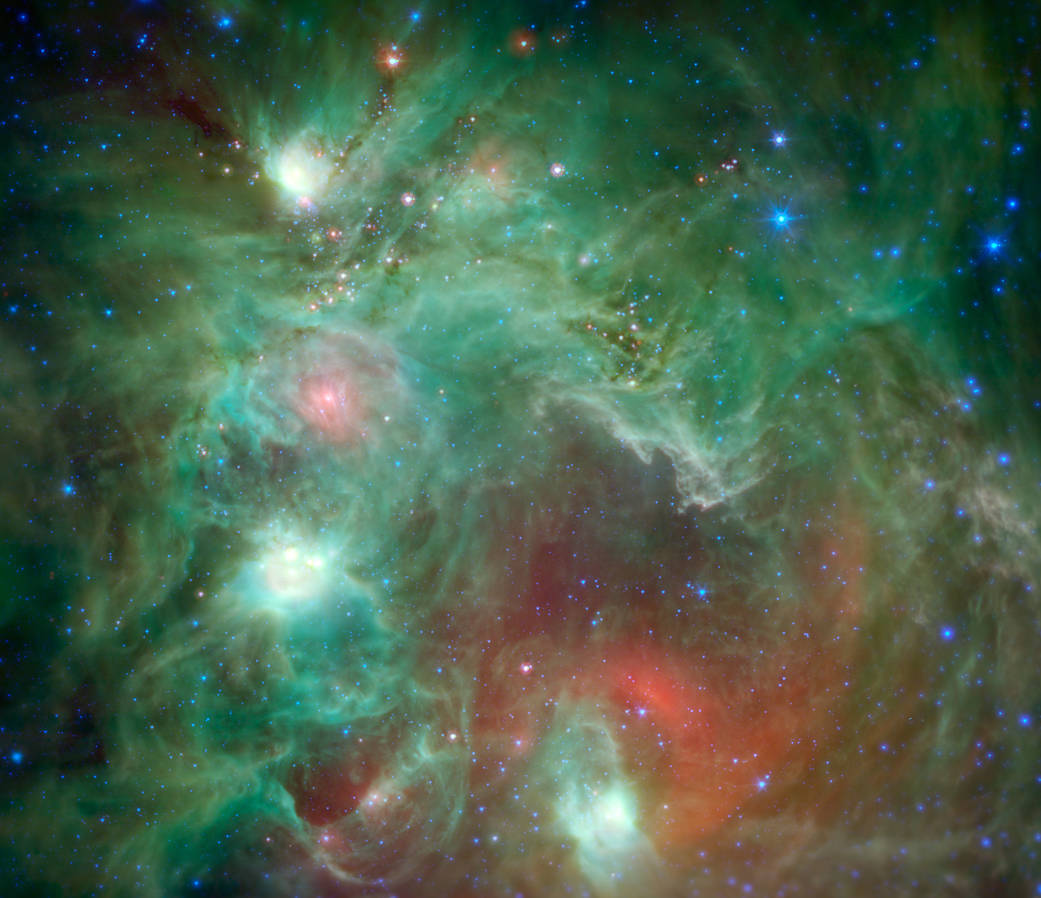猎户座的婴儿恒星
Scores of baby stars shrouded by dust are revealed in this infrared image of the star-forming region NGC 2174, as seen by NASA’s Spitzer Space Telescope. Some of the clouds in the region resemble the face of a monkey in visible-light images, hence the nebula’s nickname: the “Monkey Head.” However, in infrared images such as this, the monkey disappears. That’s because different clouds are highlighted in infrared and visible-light images.
Found in the northern reaches of the constellation Orion, NGC 2174 is located around 6,400 light-years away. Columns of dust, slightly to the right of center in the image, are being carved out of the dust by radiation and stellar winds from the hottest young stars recently born in the area.
Spitzer’s infrared view provides us with a preview of the next clusters of stars that will be born in the coming millennia. The reddish spots of light scattered through the darker filaments are infant stars swaddled by blankets of warm dust. The warm dust glows brightly at infrared wavelengths. Eventually, these stars will pop out of their dusty envelopes and their light will carve away at the dust clouds surrounding them.
In this image first published in 2015, infrared wavelengths have been assigned visible colors we see with our eyes. Light with a wavelength of 3.5 microns is shown in blue, 8.0 microns is green, and 24 microns in red. The greens show the organic molecules in the dust clouds, illuminated by starlight. Reds are caused by the thermal radiation emitted from the very hottest areas of dust.
Areas around the edges that were not observed by Spitzer have been filled in using infrared observations from NASA’s Wide Field Infrared Survey Explorer, or WISE.
Image Credit: NASA/JPL-Caltech
由NASA的斯皮策太空望远镜拍摄的恒星形成区域NGC 2174的红外图像显示,数十颗被尘埃笼罩的婴儿恒星正在形成。在可见光图像中,该区域的一些云团看起来像猴子的脸,因此该星云被称为“猴头”。然而,在这样的红外图像中,猴子消失了。这是因为在红外线和可见光图像中突出显示了不同的云。
NGC 2174位于猎户座北部,距离地球约6400光年。在图像中间偏右一点的尘埃柱,是由该地区最近诞生的最热的年轻恒星的辐射和恒星风从尘埃中雕刻出来。
斯皮策望远镜的红外视图为我们提供了未来数千年将诞生的下一个星团的预览。透过较暗的细丝散射的红色光点是被温暖的尘埃包裹的婴儿恒星。温暖的尘埃在红外波段发出明亮的光。最终,这些恒星将从尘封的外壳中中冒出来,它们发出的光会穿透它们周围的尘埃云。
在这张于2015年首次发布的图像中,红外波长被赋予了我们肉眼可见的颜色。波长为3.5微米的光显示为蓝色,8.0微米的光显示为绿色,24微米的光显示为红色。绿色显示的是被星光照亮的尘埃云中的有机分子。红色是由最热的尘埃区域发出的热辐射造成。
斯皮策没有观测到的边缘区域已经被NASA的广域红外勘测探测器(WISE)的红外观测填补。
影像来源:NASA/JPL-Caltech

